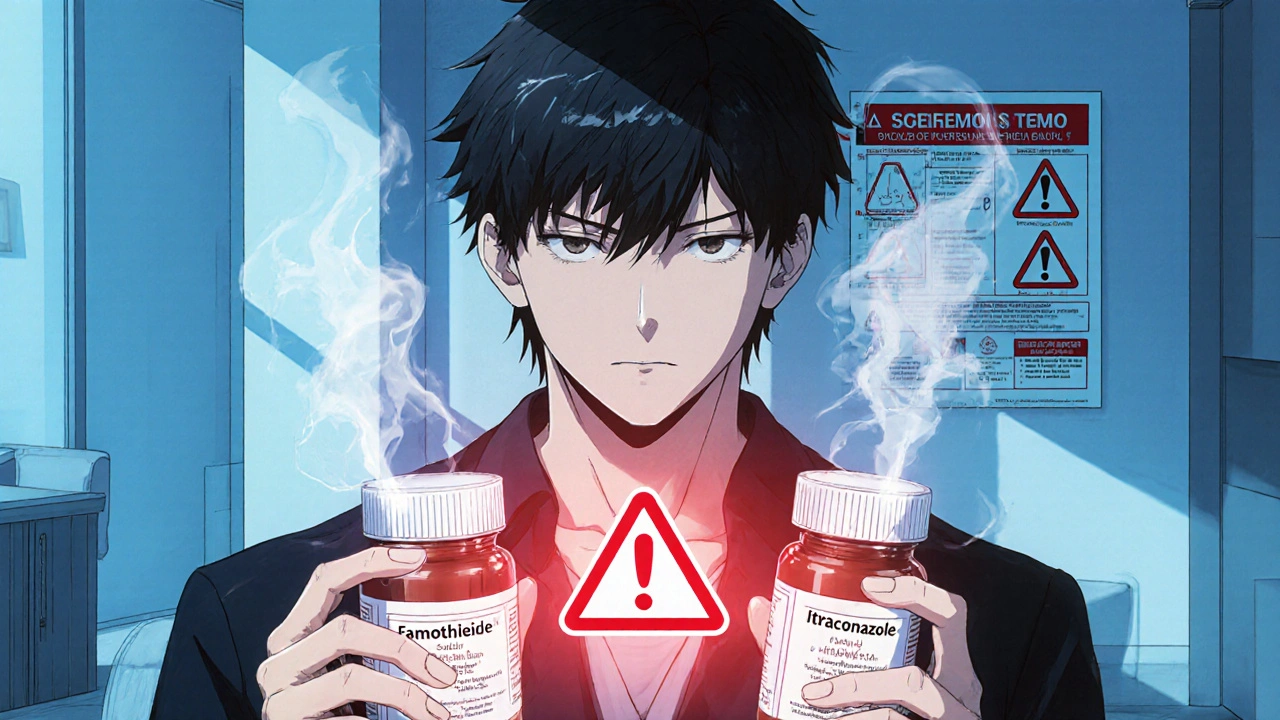Antifungal/Antiviral Interaction Checker
Check Your Medications
Select medications to see results
Many people take H2 blockers like famotidine or cimetidine for heartburn or acid reflux without realizing they could be quietly sabotaging their antiviral or antifungal treatment. These medications reduce stomach acid, which sounds harmless - until you’re taking drugs that absolutely need that acid to work. A simple mix of heartburn medicine and an antifungal pill can lead to treatment failure, hospitalization, or even death in severe cases. This isn’t theoretical. It’s happening right now in clinics and homes across the country.
How H2 Blockers Really Work
H2 blockers - histamine H2-receptor antagonists - stop your stomach from making too much acid. They do this by blocking histamine from telling your stomach cells to produce acid. The result? Your stomach pH rises from a strong acidic 1-3 to a much milder 4-6. That’s great for relieving heartburn, but terrible for certain drugs that need acidity to dissolve and get absorbed.
There are three H2 blockers still on the market in the U.S.: famotidine (Pepcid), cimetidine (Tagamet), and nizatidine (Axid). Ranitidine (Zantac) was pulled in 2020 because it contained a cancer-causing contaminant. Among these, cimetidine is the most dangerous when mixed with other medications. Why? It has a chemical structure that interferes with liver enzymes - specifically the CYP450 system - that break down many drugs. Famotidine and nizatidine don’t do this. That’s why doctors now prefer famotidine over cimetidine when acid control is needed alongside other meds.
Why Antifungals Are Especially at Risk
Not all antifungals are the same. Some need acid to dissolve. Others don’t care. The difference can mean the difference between curing an infection and watching it spread.
Itraconazole is a classic example. It’s used for serious fungal infections like aspergillosis and histoplasmosis. But it’s poorly soluble in water. Without enough stomach acid, it barely dissolves - and if it doesn’t dissolve, your body can’t absorb it. Studies show H2 blockers can cut itraconazole absorption by 40-60%. That’s not a small drop. That’s enough to make the drug useless.
On the flip side, fluconazole doesn’t care about stomach pH. It dissolves easily in water, so H2 blockers don’t affect it. That’s why fluconazole is often chosen over itraconazole when a patient needs acid suppression. The same goes for voriconazole - it’s mostly unaffected by pH changes, but here’s the twist: voriconazole can actually raise cimetidine levels in your blood by blocking how your liver breaks it down. That can lead to side effects like confusion, dizziness, or even heart rhythm problems.
Isavuconazole is newer and smarter. It has fewer enzyme interactions and doesn’t rely as much on stomach acid. In a major clinical trial, it performed just as well as voriconazole for treating invasive aspergillosis - but with 26% fewer drug interaction problems. That’s why it’s becoming the go-to choice in complex cases.
Antivirals and the Silent Drop in Effectiveness
Antivirals are just as vulnerable. Take atazanavir, an HIV medication. It needs a very acidic environment to be absorbed. When taken with famotidine, its blood levels can drop by up to 77%. That’s not just a reduction - it’s a collapse. And if HIV drug levels fall too low, the virus can mutate and become resistant. Once that happens, the drug stops working forever.
The FDA reviewed 42 antiviral labels in 2022 and found that 68% warned about interactions with acid-reducing drugs. But here’s the scary part: 31% of those drugs had no clear instructions on how to avoid the problem. Patients were left guessing. A 2022 survey of hospital pharmacists showed only 43% consistently told patients to time their meds properly. That means over half the people taking these combinations are at risk.
Other antivirals like dasatinib (used in some viral-related cancers) and ketoconazole (an older antifungal sometimes used off-label) also suffer the same fate. Their absorption tanks when stomach acid is suppressed.

Cimetidine vs. Famotidine: The Real Difference
Not all H2 blockers are created equal. Cimetidine is the old-school option. It’s cheap. But it’s a troublemaker. It blocks liver enzymes that break down dozens of drugs - including many antifungals and antivirals. That means even if the drug dissolves fine, your body can’t clear it properly. Levels build up. Toxicity kicks in.
Famotidine? It doesn’t touch those enzymes. It only lowers acid. That makes it the safer choice. The University of Liverpool’s drug interaction database shows cimetidine is involved in 63% of all serious interactions with antifungals and antivirals. Famotidine? Only 12%. That’s why, since 2019, prescriptions for cimetidine have dropped 92% in patients on azole antifungals. Doctors switched to famotidine - not because it’s better for heartburn, but because it’s less likely to kill your other meds.
What You Should Do - Practical Steps
If you’re on an antiviral or antifungal, here’s what you need to do right now:
- Check your meds. Do you take famotidine, cimetidine, or any other acid reducer? Write them down.
- Look up your antiviral or antifungal. Does it need acid to work? Itraconazole? Atazanavir? Ketoconazole? If yes, you’re at risk.
- Never take them together. If you must use an H2 blocker, take your antifungal or antiviral at least 2 hours before it. For itraconazole tablets, this is non-negotiable. For the liquid form? It’s more forgiving - but still not risk-free.
- Ask for therapeutic drug monitoring. If you’re on voriconazole or itraconazole, ask your doctor to check your blood levels after two weeks. Normal range is 2-5 mcg/mL. Below that? Your dose may need adjusting.
- Ask about alternatives. Can you switch from itraconazole to fluconazole? From cimetidine to famotidine? From a PPI to an H2 blocker? There are often safer options.
One hospital in Atlanta tracked 117 patients on itraconazole and H2 blockers. Of those who took them together without timing instructions, 38% had treatment failure. Of those who waited 2 hours between doses, only 6% failed. That’s a 6-fold difference.

Why This Keeps Happening
Doctors aren’t ignoring this. The problem is complexity. A patient with HIV might also have a fungal infection. They’re on 8-10 medications. One prescribes an H2 blocker for heartburn. Another prescribes an antiviral. No one connects the dots. Pharmacies don’t always flag it. Patients don’t know to ask.
And it’s not just patients. A 2023 IQVIA analysis showed that H2 blocker prescriptions dropped 18% in patients on azole antifungals - but not because doctors understood the interaction. It was because they switched to proton pump inhibitors (PPIs) - which are even worse. PPIs suppress acid for 24+ hours. H2 blockers only last 6-12. That’s why guidelines now say: if you need acid suppression, use an H2 blocker - but use famotidine, and separate it by 2 hours.
What’s Coming Next
The FDA is pushing for changes. In late 2023, they proposed new rules requiring all drugs affected by stomach pH to include clear timing instructions on their labels. That could cut interaction-related failures by 35%.
Meanwhile, researchers are testing new formulations - like lipid-based itraconazole - that work even in low-acid environments. Early trials show promise. If they succeed, we might one day stop worrying about this interaction altogether.
Until then, the message is simple: if you’re taking an antiviral or antifungal, don’t assume your heartburn medicine is harmless. Ask. Check. Time it right. Your treatment could depend on it.
